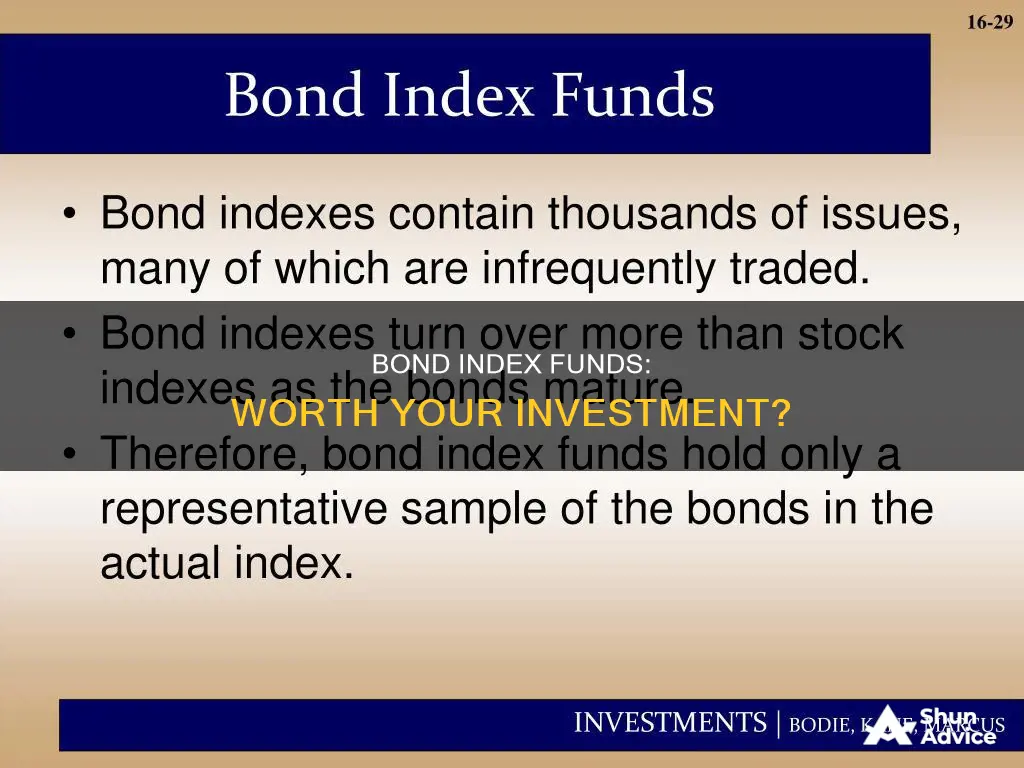
Investing in bond index funds is an appealing option for those looking to diversify their portfolio and mitigate losses. Bonds are a loan to an issuer, such as a government, municipality, or corporation, which promises to pay back the loan with interest. Bond index funds are a type of investment fund that pools money from multiple investors to purchase a broad range of bonds. While investing in individual bonds can offer more control and transparency, it often requires a greater financial commitment and more time and resources to manage. On the other hand, bond index funds provide easier diversification with a lower initial investment, but investors have less control over the specific bonds in their portfolio. When deciding whether to invest in bond index funds, it's essential to consider factors such as the amount of money available, research abilities, risk tolerance, and investment goals.
| Characteristics | Values |
|---|---|
| Control and transparency | Lower in bond funds |
| Research and oversight | Lower in bond funds |
| Credit risk | Depends on the type of bond fund |
| Expense ratios | Bond funds charge expense ratios |
| Income frequency | Generally twice a year for individual bonds, monthly for bond funds |
| Minimum investment amount | Greater for individual bonds |
| Liquidity | Lower for individual bonds |
| Impact of rising or falling rates | Potentially lower for individual bonds |
What You'll Learn

Individual bonds vs bond funds
There are several factors to consider when deciding between investing in individual bonds or bond funds. These include diversification, convenience, costs, and control over maturity. Here is a detailed comparison of the two options:
Individual Bonds
The key benefits of owning individual bonds include:
- Reliable income stream: Individual bonds typically pay semi-annual coupon or interest payments, providing a steady and predictable income that is great for planning and meeting periodic expenses.
- Predictable value at maturity: Individual bonds have a definite maturity date, and barring default, investors will receive the par value of the bond at maturity. This predictability can help investors ignore potential price fluctuations.
- Customised portfolio: Investors can build a bond portfolio tailored to their investment objectives and risk tolerance, selecting bonds from various industries with different maturity dates and yield rates.
- Superior financial disclosures: Corporate bond issuers are required to file quarterly financial statements, providing individual bond investors with more detailed and frequent information to assess the issuing company's financial health and the bond's potential upside.
- Easier to buy and sell: The corporate bond market is dynamic, and individual bonds can be traded quickly at any time during the day, allowing investors to act swiftly in response to market events.
- Greater transparency: Individual bonds trade relative to their $1,000 par value, providing investors with higher pricing transparency compared to bond funds.
- Know your investment: When investing in individual corporate bonds, you know exactly what you are investing in, including the issuer, yield, maturity date, price, credit spread, and other information to assess the bond's risk and return.
- Fixed coupon payments: Individual bond investors receive contractual coupon payments at specific times, providing a level of security for income investors.
- Return of principal at maturity: Individual bonds are required to repay investors their $1,000 face value at maturity, providing a level of certainty and security.
However, there are also some downsides to owning individual bonds:
- Diversification challenge: Achieving adequate diversification across different asset classes and issuers can be challenging and cost-prohibitive for individual bond investors.
- Pricing disadvantages: Individual investors often face less attractive pricing compared to institutional investors who purchase large quantities of bonds.
- Time-intensive: Researching and managing a strategy for individual bonds can be time-consuming, given the vast number of issuers and bonds available in the market.
Bond Funds
On the other hand, bond funds offer the following advantages:
- Greater diversification: Bond funds provide exposure to a basket of bonds, making it easier to achieve a diversified bond portfolio with a smaller investment.
- Access to institutional pricing: Bond funds, due to their larger purchasing power, often receive better pricing on individual bonds compared to individual investors.
- Professional management: Actively managed bond funds benefit from professional expertise, especially when navigating riskier segments of the fixed income market, such as high-yield bonds or preferred securities.
- Monthly distributions: Bond funds typically make monthly distributions, providing investors with more frequent payments compared to the semi-annual payments of individual bonds.
However, there are also some considerations when investing in bond funds:
- Management fees: Actively managed bond funds may charge higher management fees, potentially leading to lower investment returns.
- Net asset value fluctuations: The net asset value (NAV) of bond funds fluctuates with the market and interest rate changes, making it less predictable and less attractive for planning future liabilities.
- Tax complexities: Bond funds pool money, leading to more complex cost basis and tax consequences. Additionally, investors have less control over the buying and selling of individual bonds, which can result in unexpected capital gain distributions.
In conclusion, the decision between investing in individual bonds or bond funds depends on various factors, including investment goals, time horizon, risk tolerance, and behavioural preferences. Individual bonds offer predictability, customisation, and transparency, while bond funds provide greater diversification, professional management, and access to institutional pricing. It is essential to carefully consider the advantages and disadvantages of each option before making an investment decision.
The S&P 500 Index Fund: A Smart Investment Move
You may want to see also

Pros and cons of bond funds
Bond funds are a type of investment fund that focuses on investing in bonds. They are a popular choice for investors looking for a diversified portfolio and a reliable income stream. Here are some of the pros and cons of investing in bond funds:
Pros of Bond Funds:
- Diversification: Bond funds provide access to a diversified portfolio of bonds from different issuers, maturity dates, coupon rates, and credit ratings. This diversification helps reduce the overall risk of the investment.
- Institutional Pricing: Bond funds have better pricing power than individual investors when purchasing bonds, leading to potentially higher yields.
- Professional Management: Bond funds are actively managed by professionals who have the knowledge and expertise to navigate the complex and risky segments of the fixed-income market. They can adjust the portfolio according to the economic and interest rate environment.
- Compounding Returns: Bond funds distribute monthly payments that can be reinvested into the fund to compound returns.
Cons of Bond Funds:
- Management Fees: Actively managed bond funds often come with higher management fees, which may lead to lower overall returns compared to individual bonds.
- Net Asset Value Fluctuation: The net asset value (NAV) of bond funds fluctuates with the market and interest rates. This makes it challenging to predict future NAV and plan for specific future liabilities.
- Tax Consequences: Bond funds pool money from multiple investors, leading to a more complex cost basis for tax purposes. Additionally, the buying and selling of individual bonds within the fund may result in unexpected capital gain distributions.
- No Guaranteed Principal Recovery: Unlike individual bonds, there is no guarantee that you will recover your principal investment at a specific time, especially in a rising-rate environment.
Ultimately, the decision to invest in bond funds depends on your personal investment goals, time horizon, and risk tolerance. Bond funds offer the benefits of diversification, professional management, and access to institutional pricing but come with the trade-offs of management fees, fluctuating NAV, and complex tax considerations.
Invest Smartly: SBI Mutual Fund Lumpsum Guide
You may want to see also

Bond fund management fees
When considering investing in bond index funds, one of the key factors to take into account is the management fee. Management fees are present in almost all investment management and advisory services, and they are paid to professionals who manage investments on a client's behalf. These fees can cover a range of expenses, including portfolio management, advisory services, and administrative costs.
The management fee for bond funds can be a significant downside, as more actively traded bond funds tend to have higher fees, which may result in lower returns. These fees are typically calculated as a percentage of the total assets under management (AUM) and can range from 0.20% to 2.00%, depending on factors such as management style and investment size. For example, an investment of $10,000 with a 2.00% annual management fee would incur a $200 yearly fee, or $50 per quarter.
Fees for bond mutual funds and ETFs can vary widely, typically ranging from 0.05% to 0.8% of assets under management, depending on the type of bond fund and whether it is an index or actively managed fund. Separately managed bond accounts, where an outside manager buys and sells individual bonds for an investor, usually have an annual fee between 0.2% and 0.7%, depending on the account size.
It is important to note that management fees are not the only costs associated with investing in bond funds. The management expense ratio (MER) includes the management fee as well as other operating expenses, such as accounting, legal fees, and taxes. When making investment decisions, it is crucial to consider the entire MER, as it is often higher than the management fee alone.
Additionally, when investing in bonds through a broker or financial advisor, there may be mark-ups or commissions involved, even if a separate fee for bond management is not charged. These mark-ups or commissions are the difference between the price the brokerage firm paid for the bond and the price they sell it to the client, and they may not be disclosed.
To make informed investment decisions, it is essential to understand all the associated fees and expenses. Investors should ask their financial advisors or brokers about any mark-ups, commissions, and fees charged on bond purchases, sales, or management.
Manulife Financial: A Regulated Mutual Fund Company?
You may want to see also

Interest rate risk
When interest rates rise, existing bonds become less desirable because their coupon rates are fixed, and investors can get a higher return by investing in newer bonds with higher coupon rates. As a result, the price of existing bonds falls to compensate for the difference in coupon rates.
For example, let's consider a 10-year government bond with a face value of $10,000 and an annual interest rate of 4%, paid semi-annually. If interest rates rise, the price of this bond will likely fall in the secondary market. If you need to sell the bond before it matures, you may have to sell it at a lower price than what you paid for it, resulting in a loss of principal.
The impact of interest rate risk can be mitigated by holding bonds to maturity. By doing so, investors will receive the full par value of the bond upon maturity, regardless of the prevailing interest rates. However, holding bonds to maturity comes with an opportunity cost, as investors may miss out on the higher coupon rates offered by newer bonds during the holding period.
Additionally, the impact of interest rate risk may be greater for bond funds than for individual bonds. Bond funds do not have a defined maturity date, and investors choose when to purchase and sell. As a result, investors in bond funds may be more likely to experience volatility in the value of their investment due to changing interest rates.
ETFs for Retirement: A Smart Investment Strategy?
You may want to see also

Credit risk
It's important to note that diversification does not guarantee protection against losses in a declining market. All investments carry some degree of risk, and investors should carefully consider their investment objectives, risk tolerance, and financial situation as well as the specific characteristics of the investment before making any investment decisions.
International Funds: Invest or Avoid?
You may want to see also







